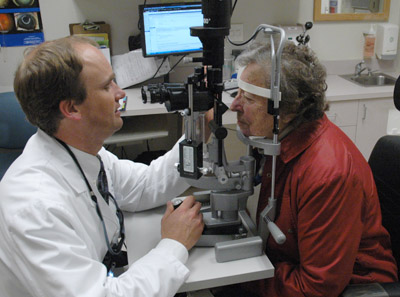
Sacramento artist Ruth Rippon (right) sought treatment at UC Davis for macular degeneration to help save or even improve her eyesight. A fan of reading the daily newspaper, she has noticed a difference. "I can see more than just the headlines now," she said.
Posted May 11, 2011
UC Davis ophthalmologists are among the group of national researchers reporting results from the first year of a two-year clinical trial that showed Avastin, a drug approved to treat some cancers that is commonly used off-label to treat age-related macular degeneration (AMD), is as effective as the Food and Drug Administration-approved drug Lucentis for treating AMD.
The report, from the Comparison of AMD Treatments Trials (CATT), published online in the New England Journal of Medicine on Sunday, May 1. The study is funded by the National Eye Institute (NEI), a part of the National Institutes of Health.
"It was important for UC Davis to be a part of this study," said Susanna Park, professor of ophthalmology at the UC Davis Health System Eye Center and the principal investigator for the UC Davis CATT study. “Currently, our patients are given many options for treating wet macular degeneration without solid data on the relative efficacy of those options. By testing two drugs and two dosing regimens side by side, the results of this study will allow us to base our treatment recommendations on solid scientific data."
For older Americans, leading cause of vision loss
Age-related macular degeneration is the leading cause of vision loss and blindness in older Americans. In its advanced stages, the wet form of the disease spurs the growth of abnormal blood vessels, which leak fluid and blood into the macula and obscure vision. The macula is the central portion of the retina that allows individuals to look straight ahead and to perceive fine visual detail. Accumulation of fluid and blood damages the macula, causing loss of central vision. AMD can severely impede mobility and independence. Many patients are unable to drive, read, recognize faces or perform tasks that require hand-eye coordination.
“Over 250,000 patients are treated each year for AMD, and a substantial number of them receive Avastin. Given the lack of efficacy data regarding Avastin for AMD treatment, the NEI had an obligation to patients and clinicians to conduct this study,” said Paul A. Sieving, director of the NEI.
 “By testing two drugs and two dosing regimens side by side, the results of this study will allow us to base our treatment recommendations on solid scientific data.”
“By testing two drugs and two dosing regimens side by side, the results of this study will allow us to base our treatment recommendations on solid scientific data.”
— Susanna Park
Ruth Rippon, a Sacramento artist and participant in the UC Davis CATT study, was referred to UC Davis retinal specialists because her eyesight was continually declining, something she noticed while reading the newspaper each day. Diagnosed with AMD, she began treatments through the study to save and potentially improve her sight. She does not know which medication she received. However, her vision is better.
“I can see more than just the headlines now,” Rippon said. “I’m really glad that the study helped me and that it could also help others with the disease.”
Drug development
Genentech, the maker of both drugs, originally developed Avastin to prevent blood-vessel growth that enables cancerous tumors to develop and spread. In 2004, the FDA approved Avastin for the systemic treatment of metastatic colon cancer. Genentech later developed Lucentis, derived from a protein similar to Avastin, specifically for injection in the eye to block blood-vessel growth in macular degeneration.
In 2005, two Genentech-sponsored clinical trials established Lucentis as highly effective for the treatment of wet AMD. During the year between the announcement of the trial results and the release of Lucentis, ophthalmologists began injecting AMD patients with low doses of Avastin, due to its similarity to Lucentis and its availability. The FDA has not licensed Avastin for the treatment of AMD.
Numerous physicians noted a beneficial treatment effect and Avastin's use grew rapidly despite the lack of data on safety, efficacy and dosing from randomized clinical trials to support its use. Ophthalmologists used Avastin primarily as needed, or pro re nata, when there was evidence of active disease. The FDA approved Lucentis in 2006. However, most clinicians adopted as-needed dosing for Lucentis, which was a departure from FDA-approved labeling and the monthly dosing schedule evaluated in the Genentech-sponsored clinical trials. It was not known if as-needed dosing would produce the same long-term vision benefits that were achieved with monthly administration.
UC Davis Health System Eye Center
The UC Davis Health System Eye Center is a leader in collaborative vision research that is leading to cures for blinding eye disease and in providing state-of-the-art, world-class eye care. For more information, visit www.ucdmc.ucdavis.edu/eyecenter/
Initial results from the clinical trial
NEI launched CATT in 2008 to compare Lucentis and Avastin for treating wet AMD. The study has now reported results for 1,185 patients treated at 43 clinical centers in the United States. At UC Davis, 23 patients are participating in the study. Patients were randomly assigned and treated with one of four regimens for a year. They received Lucentis monthly or as needed, or Avastin monthly or as needed. Enrollment criteria required that study participants had active disease.
Patients in the monthly dosing groups received an initial treatment and then had an injection every 28 days. Patients in the as-needed groups received an initial treatment and were then examined every 28 days to determine medical need for additional treatment. As-needed groups received subsequent treatment when there were signs of disease activity, such as fluid in the retina. Ophthalmologists involved in patient care did not know which study drug a patient was getting, to make sure that the data was not affected by how anyone felt about the treatment.
Change in visual acuity served as the primary outcome measure for CATT. Thus far, visual-acuity improvement was virtually identical (within one letter difference on an eye chart) for either drug when given monthly. In addition, no difference was found in the percentage of patients who had an important gain or loss in visual function. Also, when each drug was given on an as-needed schedule, there also was no difference (within one letter) between drugs. As-needed dosing required four to five fewer injections per year than monthly treatment. Visual gains were about two letters less with as-needed than with monthly treatment, but overall visual results were still excellent.
“In addition to the primary finding of equivalence between Lucentis and Avastin for visual acuity, CATT also demonstrates that as-needed dosing is a viable treatment option for either of these drugs,” said Daniel F. Martin, study chair for CATT and chairman of the Cole Eye Institute at the Cleveland Clinic. “Substantial visual acuity gains may be accomplished with a lower treatment burden.”
The National Eye Institute, part of the National Institutes of Health, leads the federal government's research on the visual system and eye diseases. The institute supports basic and clinical science programs that result in the development of sight-saving treatments. For more information, visit www.nei.nih.gov.
Adverse events indicate development or worsening of a medical condition. They may or may not be causally associated with the clinical trial treatment, but they are always monitored and reported in any clinical trial. The median age of patients in CATT was over 80 years, and a high rate of hospitalizations might be anticipated as a result of chronic or acute medical conditions more common to older populations.
Serious adverse events (primarily hospitalizations) occurred at a 24 percent rate for patients receiving Avastin and a 19 percent rate for patients receiving Lucentis. These events were distributed across many different conditions, most of which were not associated with Avastin in cancer clinical trials, where the drug was administered at 500 times the dose used for AMD. The number of deaths, heart attacks and strokes were low and similar for both drugs during the study. CATT was not capable of determining whether there is an association between a particular adverse event and treatment. Differences in serious adverse event rates require further study.
CATT investigators will continue to follow patients through a second year of treatment. These additional data will provide information on longer-term effects of the drugs on vision and safety.
The FDA has not evaluated data from the CATT trial.
Find more information about this clinical trial (NCT00593450) at www.clinicaltrials.gov.